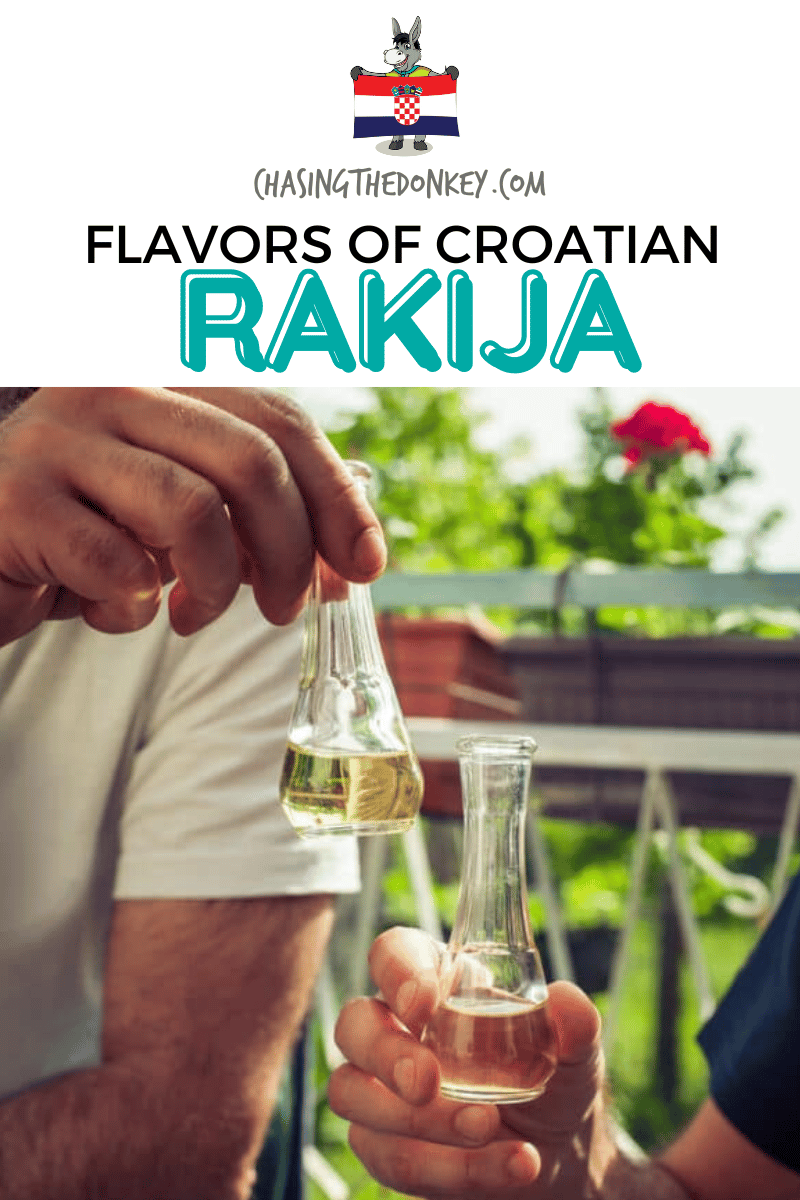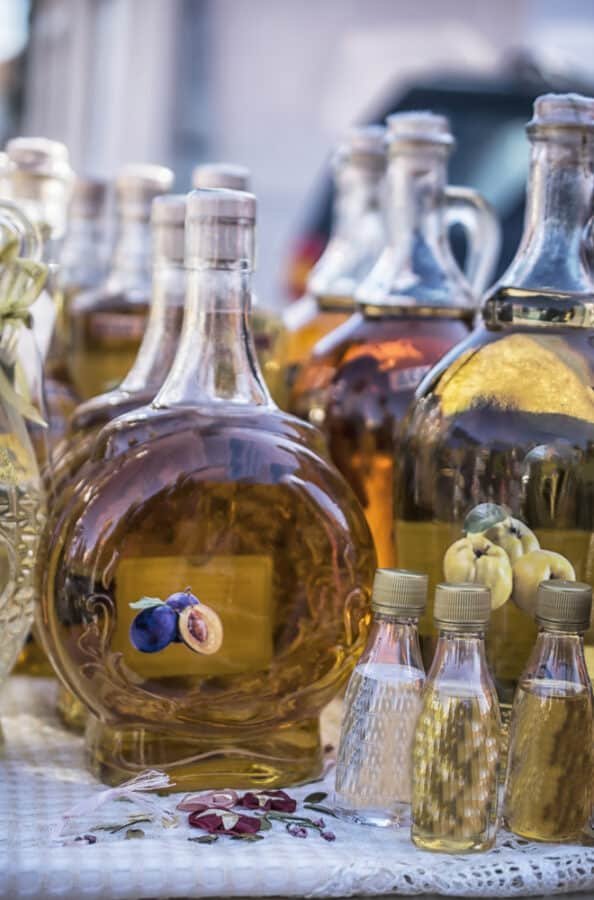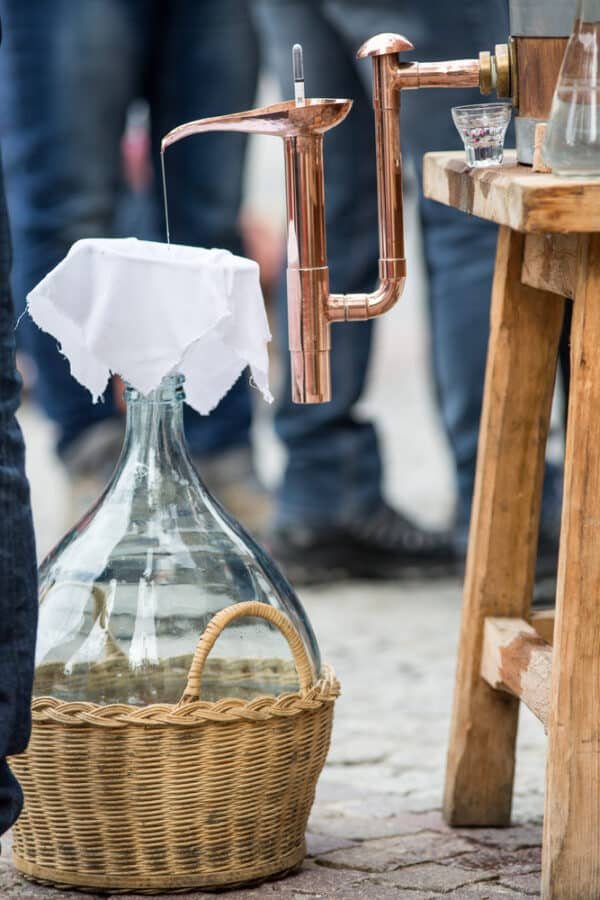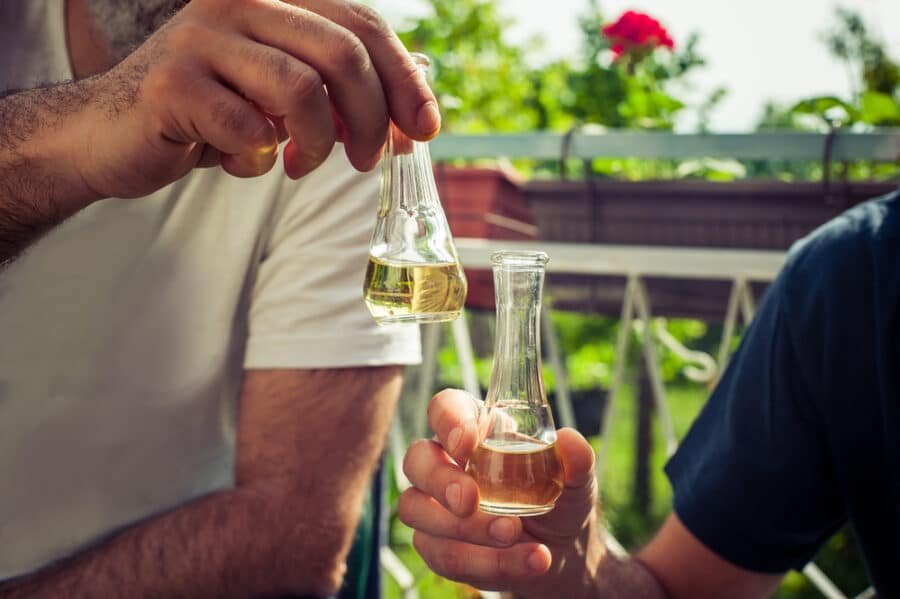In Croatia, rakija isn’t just an alcoholic drink; it’s the national drink. Also known as traditional Croatian brandy, it is distilled from local fruit to make an array of rakija varieties, each with its own unique flair – and strong taste.
From the renowned slivovitz to the rich carob rakija, these varieties represent more than just various types of rakija; they’re a testament to the country’s rich heritage. A shot of rakija, embodying the spirit of many Balkan countries, is a common sight at social gatherings.
What makes these drinks special are their basic ingredients, each carefully chosen to create distinct flavors. Personally, walnut rakija holds a special place in my heart. It’s not only a favorite but also a family affair, as my husband crafts his own home-made Croatian rakija.
Interestingly, this beloved drink is more than a treat; my Croatian mother-in-law swears by its efficacy in soothing stomach pain – and as a natural remedy, I have to say she isn’t wrong. It really works. Dive into the diverse world of Croatian rakija, where each sip is a celebration of culture and tradition.

Are you a fan of strong spirits and unique flavors?
Look no further than Croatia’s beloved rakija! This traditional fruit brandy has been enjoyed for centuries in the Balkans, with each region boasting its own distinct variety. From the sweet plum notes of slivovitz to the herbal kick of travarica, we’re taking a deep dive into the world of Croatian rakija and all its delicious nuances.
So please sit back, grab a glass (or two), and let’s explore this fascinating spirit together.
Skip Ahead To My Advice Here!
Croatian Rakija – What Is Rakija

Rakija is a type of fruit brandy popular in Croatia. It is made by fermenting and distilling fruit, usually grapes or plums. Rakija can be clear to amber in color and has a robust and fruity flavor.
Croatia is home to many different types of rakija (also known as Croatian grappa or Croatian schnapps ), each with its own unique flavor. Slivovitz is a plum brandy that is clear and has a strong, sweet flavor. Travarica is an herbal brandy that is amber in color and has a bitter, medicinal taste. Other popular types of rakija include lozovača (grape brandy), šljivovica (plum brandy), and travarica (herbal brandy).
No matter what your taste, there is sure to be a type of rakija that you will enjoy! Although it is often consumed straight, rakija can also be used in cocktails or mixed with other drinks. For example, slivovitz is commonly mixed with soda water to create a refreshing drink known as šljivovica soda.
Types Of Croatian Rakija
Rakija can vary in taste depending on the type of fruit used, as well as the aging process. Younger rakijas tend to be more fruity and sweet, while older rakijas are often more dry and complex. Some rakijas are even aged in oak barrels (this is how Mr. Chasing the Donkey makes his), which can give them a smooth, woody flavor.
No matter what your taste preference is, there is sure to be a type of rakija that you will enjoy.
Šljivovica (Plum)

Šljivovica, also known as plum brandy, is a clear spirit made from distilled plums. It is the most popular type of rakija in Croatia, and its name comes from the Slavic word for plum, “sljiva.” Šljivovica typically has around 40% alcohol content and has a strong plum flavor with a slightly sweet finish. It is often served neat or on the rocks but can also be used in cocktails.
Travarica (Herb)
Travarica is a type of Croatian rakija that is distilled from herbs, typically including wormwood, mint, and rosemary. It is often used as a base for cocktails. Travarica can be clear or yellow in color and has a strong, herbal flavor.
Lozovača (Grape)
Lozovača is a type of Croatian rakija made from grapes. It is typically clear in color and has a strong, fruity flavor.
Viljamovka (Williams Pears)
Viljamovka is a type of Croatian rakija that is made from Williams pears. It is clear in color and has a fruity, floral aroma. The flavor is sweet and slightly spicy, with a long-lasting finish. Viljamovka is typically served as an after-dinner drink or as an aperitif.
Medica (Honey)
Medica is a type of Croatian rakija that is steeped with honey. It has a strong, sweet flavor with a hint of bitterness. Some say it tastes like a cross between honey and brandy. Medica is popular at the Christmas markets. This is probably my personal favorite Croatian liquor.
Brands We Use And Trust
Croatian Liqueurs
Called liker in Croatian, these Croatian liqueurs are made using the rakijas listed above as a base, whereas other things like fruit and sugar are added to make it much sweeter. The most popular Croatian liker is pelinkovac.
Pelinkovac (Bitter Herbal)
Pelinkovac is a bitter liqueur made from wormwood, mint, and other herbs. It is popular in Croatia, Bosnia, and Herzegovina and is sometimes referred to as “Croatian absinthe.
Pelinkovac has a long history in Croatia, dating back to the 18th century. The first known recipe for pelinkovac was published in 1759 by Franjo Josip Frankopan, a Croatian nobleman. Since then, the recipe has been passed down through the generations and is now produced commercially.
Pelinkovac is usually drunk neat or on the rocks, but it can also be used in cocktails. It has a strong herbal flavor that is reminiscent of absinthe but with a bitterness that is unique to pelinkovac.
If you’re looking to try something new and different, pelinkovac is definitely worth seeking out. You may just find that it’s your new favorite drink!
Other Types Of Croatian Liker
- Orahovac (walnut)
- Jabukovača (apple)
- Maraschino (maraschino sour cherries)
- Višnjevac (cherry)
- Kruskovac (pear)
- Borovniček (blueberries)
- Teranino (teran wine)
- Arancino (orange)
- Mirta (myrtle)
- Rozulin (rose petals)
- Limončelo (lemon)
How Do I Say That?
| Rakija Type | Pronunciation |
|---|---|
| Kruškovac | kroosh-koh-vatz |
| Medica | meeh-di-sa |
| Orahovac | or-rah-hoe-vatz |
| Pelinkovac | peh-lyn-koh-vatz |
| Rakija | rah-kee-yah |
| Šljivovica | shli-vo-vit-za |
| Travarica | tra-vah-ree-tzah |
Production And Consumption Of Rakija In Croatia

Croatia is well known for its production and consumption of rakija, a type of brandy made from fermented fruit. The most common type of rakija in Croatia is made from grapes, but it can also be made from other fruits such as plums, quinces, figs, and pears. Rakija is typically around 40% alcohol by volume, but it can range anywhere from 35-60%.
Croatians love their rakija, and it is not uncommon to find a bottle of the homemade stuff in every household. It is often served as an aperitif or after a meal and is also used for medicinal purposes. Rakija plays an important role in Croatian culture and traditions and is often given as a gift on special occasions.
The Effects And Benefits Of Drinking Rakija
Drinking rakija has numerous health benefits. It is rich in antioxidants and has been shown to boost the immune system, improve circulation, and reduce inflammation. Rakija is also thought to have digestive properties, making it beneficial for those suffering from stomach problems or indigestion.
In our house, we use rakija on insect bites – and during summer, when those pesky mosquitos swarm, a dousing of rakija keeps them at bay.

Croatian rakija is typically enjoyed in a special glass shaped like a pear. This unique glassware is said to enhance the flavor of the brandy, and many aficionados believe it’s the only way to properly enjoy this spirit. While a pear-shaped glass is the most traditional way to serve Croatian brandy, some people prefer to drink it from a snifter or other similar glass.
Recipes With Croatian Rakija – Croatian Brandy

There are many different ways to enjoy rakija, including mixing it with juice or soda water or using it as a cooking ingredient.
- Rakija & orange: one popular way to enjoy rakija is to mix it with orange juice. This refreshing cocktail is perfect for summer days spent lounging by the pool or at the beach. To make it, combine 1 part rakija with 2 parts fresh orange juice in a glass. Add ice and stir well before enjoying
- On the rocks: if you’re looking for a more traditional way to enjoy rakija, try sipping it neat or on the rocks. This strong spirit is best savored slowly, so take your time and enjoy the complex flavor profile. Rakija can also be used in cooking to add depth of flavor to dishes like stews and braises. Substitute rakija for wine in your favorite recipe
- With coffee: rakija can also be added to coffee or tea to create a warming and invigorating beverage
- Rakija-Infused Plum Cake: Use rakija-soaked plums in a classic plum cake recipe. The rakija-infused plums add a delightful twist to the traditional dessert
- Rakija-Marinated Grilled Meat: Marinate meat, such as pork or beef, in a mixture of rakija, garlic, olive oil, and herbs. Allow the flavors to infuse for a few hours before grilling. The rakija helps tenderize the meat and adds a distinct flavor
- Rakija-Spiked Truffles: Make chocolate truffles and add a splash of rakija to the mixture before shaping them into balls. The rakija will give the truffles a unique taste and aroma
- Rakija-Infused Fruit Salad: Prepare a refreshing fruit salad and drizzle it with a dressing made from rakija, honey, and lemon juice. Allow the fruits to soak in the dressing for a while before serving
- Rakija Sour Cocktail: Create a twist on the classic Whiskey Sour cocktail by substituting whiskey with rakija. Mix rakija, lemon juice, simple syrup, and a dash of bitters in a shaker with ice. Strain and serve in a glass garnished with a lemon twist.
- Remember to use rakija in moderation, as it is a strong spirit. The amount of rakija required in these recipes may vary based on personal preference, so feel free to adjust the quantities to suit your taste.
As you can see, there is a lot of variety when it comes to Croatian rakija. Whether you prefer the sweet and fragrant slivovitz or the earthy and herbal travarica, there’s a Croatian rakija to suit you.
Next time you find yourself in Croatia, don’t miss the chance to indulge in its famous drink, rakija. This traditional drink is a must-try for curious travelers looking to experience the authentic flavors and culture of the region.

